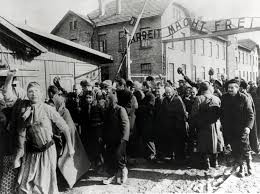
The Allied soldiers who liberated Auschwitz on January 27, 1945 discovered an unprecedented factory of death.
Regarding what he expected when entering the gates of Auschwitz, Ivan Martynushkin, a soldier from the 60th Army of the First Ukrainian Front, one of the first Allied soldiers to reach Auschwitz on January 27, 1945, said, “We knew nothing.”
“Only the highest-ranking officers of the General Staff had perhaps heard of the camp,” he recalled. As Martynushkin and his fellow Soviet soldiers entered the camp, they were immediately struck by the vastness of the camp and an intense burning smell that hung over the massive area. Little did they know, they were about to witness unimaginable horrors they could never forget.
Auschwitz, the largest Nazi concentration camp, was liberated 80 years ago. Here’s a brief description of the liberating troops discovered.
Factory of death
Auschwitz stretched for many miles. It consisted of three main camps and dozens of smaller subcamps. The largest camp within the Auschwitz complex was known as Birkenau. Over 1.3 million people were sent to Auschwitz; of these about 1.1 million were murdered. Jews made up the largest group of Auschwitz victims: over one million were sent to Auschwitz between 1940 and 1945; 960 000 Jews died there. About 150 000 non-Jewish Poles were also sent to Auschwitz (of whom approximately half died). 23,000 Gypsies were sent to Auschwitz; all but 2,000 of whom perished. And about 15,000 Soviet POWs were sent to Auschwitz and murdered there as well.
Upon arriving in Auschwitz, prisoners went through a sadistically gruesome “selection.” Most were sent straight to gas chambers — Auschwitz operated five gas chambers and crematoria at its height. Thousands of people were crammed into gas chambers and killed by poisonous gas piped into the rooms. Afterwards, their bodies were burned in crematoria which belched thick black smoke into the air night and day.
Prisoners who weren’t selected for immediate murder faced unimaginable horrors. Many were sent to “Barrack 10”, a medical site where they became victims of grotesque medical experiments by the infamous SS Captain Josef Mengele and others. Others were kept alive to perform backbreaking slave labor. Given starvation rations and no safety equipment, slave labor was a death sentence for nearly everyone who was spared the gas chambers. Dozens of subcamps existed within the Auschwitz complex, providing slave labor for German farms and companies, including famous German firms such as I.G. Farben and Siemens, which maintained factories inside the camp.
- The liberation of Auschwitz, 80 years ago
Keep Reading
Established in 1940 in the sleepy Polish town of Oswiecim, by January, 1945 Auschwitz was a sprawling, enormous camp filled with tens of thousands of prisoners and thousands of guards. When it became clear that Allied soldiers were closing in, Auschwitz’s depraved leaders scrambled to cover up their crimes.
Death march
They started by killing thousands of prisoners in order to cover up the horrific crimes of Auschwitz. On January 17 they decided they began sending about 60,000 prisoners — nearly all of them Jews — out from the camp. It was the middle of winter and the Polish countryside was bitterly cold. The starving prisoners had only thin ragged prison uniforms to wear; they were completely unprepared to walk cross-country in below-freezing weather.
Nevertheless, Auschwitz commanders forced the prisoners on a death march through the snowy woods and frozen countryside to the towns of Gliwice, 30 miles away, or Wodzislaw, 35 miles away. Anyone who fell behind was shot. It’s estimated that about 15,000 Jews died on these forced “death marches;” the roads became filled with corpses. Once in Gliwice and Wodzisław, prisoners were forced into cattle cars and sent to camps in Germany or Austria. They were given no food, water, or warm clothing in the train cars; thousands more died en route.
Zofia Stepien-Bator was a member of the Polish resistance who was caught, imprisoned, and was forced on a death march in the days before Auschwitz’s liberation. She later described what she endured:
A white road, and the large black walls of the forest on both sides…
We could hear the squeaking of the snow and the labored breathing of the tired prisoners… Gunshots kept ripping the nighttime silence apart and women were constantly thudding into the ditch for their eternal repose.Then someone ahead of me fell over. I helped her up. She was a tiny girl, totally exhausted and as completely alone as I was. Every few steps, she stumbled… She was breathing heavily and whimpering like a baby… I learned, walking along beside her and supporting her, that she didn’t have anyone at all in the world. She was a Jewish girl from the vicinity of Radom. Her parents had been killed, and she didn’t have anyone or anywhere to return to…I declared that she would come back with me to my home, and that I wouldn’t leave her. I begged her to gather up her strength, to hold out until dawn, because the sun would come up in the morning and that would make things easier. She calmed down, and went on for a while with a regular gait, and then she fell again. I picked her up. Now I was dragging her along…Nobody helped me. Prisoners barely able to stay on their feet were passing us. I had lost so much strength, I was all sweaty from the effort, but I was past the point where I could have left her. And so we found ourselves at the tail end of the column. When she fell for the final time, and I no longer had the strength to lift her up, I called for help, and somebody’s hand took hold of me and pulled me forward. I was very tired, and did not realize that I was not going to save that girl, and that I myself could die with her. One of the prisoners, a stranger, oriented herself in the situation, grabbed me by the arm, and pulled me along with her. A moment later, there was a shot. It was my poor little ward, whom I had promised not to abandon. She had stopped suffering…. The echo of that shot still rings in my memory….”
Destroying Evidence
As Soviet troops drew closer to Auschwitz, camp commanders began to destroy written records and other evidence from the camp. They shipped many of the belongings of prisoners to storage sites inside Germany, and burned records of prisoners who’d been murdered in the camp, as well as some of the personal belongings they’d plundered from prisoners and stored in vast warehouses in the camp.
They also began to dig up the ashes of the over one million people who’d perished in Auschwitz and tried to dispose of them, mainly by dumping them into the nearby Vistula and Sola Rivers. SS commanders disconnected equipment in two of crematoria and planned to send them to Germany; they made plans to blow up the remaining five crematoria before the Allies arrived. By the time Auschwitz was liberated, only one crematorium was still functional.
Zalmen Gradowski was a Jewish prisoner who was forced to run the crematoria at Auschwitz. He wrote records of the Nazis’ attempts to cover up their crimes; he buried his journal and it was found after the war, near one of the crematoria:
Lately, they have started clearing away the traces, and wherever there were a lot of ashes, they have ordered them to be ground fine, taken to the Vistula (River), and released with the current. We have dug up a lot of graves, but there are still two open (mass) graves on the grounds of the second and third crematoria. Several graves are still full of ash… A vast amount of ash from hundreds of thousands of Jews, Russians, and Poles is scattered and plowed into the grounds of the crematoria…
Liberating Auschwitz
By late January, most of Auschwitz’s prisoners and guards had left; only about 9,000 extremely ill prisoners remained. In the waning days of the camp, order broke down and prisoners who were still able to walk did their best to take care of their fellow inmates who were too ill to get out of bed. Guards were ordered to kill all remaining prisoners: they murdered about 700, but by then too many Nazis were intent on escaping to fully carry out their murderous orders.
Still, the remaining Nazi guards put up a fight. Over 200 Soviet soldiers died liberating Birkenau, the largest camp within the Auschwitz complex. When Soviet troops finally entered the gates at 3pm on January 27, 1945, they could scarcely believe their eyes. Hundreds of prisoners lay dead on the grounds, shot by Nazi guards in the last hours of the camp’s operation. Thousands of emaciated prisoners lay in the camp barracks, hovering near death and too sick to move.
A huge pile of 44,000 pairs of shoes - taken from prisoners - lay in a warehouse, along with thousands of other pieces of belongings that were plundered from prisoners. There were over 800,000 women’s dresses. Hundreds of prosthetic limbs lay in a pile. Thousands of suitcases, works of art, Jewish ritual items, and other personal effects lay catalogued in Auschwitz’s storerooms, a symbol of the scale of the crimes that had taken place there. Soviet soldiers found 88 pounds of eyeglasses. 12,000 pots and pans. Nearly 8 tons of human hair. The depravity of the Nazis, who obsessively catalogued the material possessions of those they’d murdered shocked the liberating troops.
“You Are Free”
Col. Georgii Elisavetskii, a Jewish Soviet officer, was one of the first Soviet soldiers to enter Auschwitz. He later described what he found:
When I entered the barrack, I saw living skeletons lying on the three-tiered bunks. As in a fog, I hear my soldiers saying: ‘You are free, comrades!’ I sense that they do not understand and begin speaking to them in Russian, Polish, German, Ukrainian dialects; unbuttoning my leather jacket, I show them my medals…. Then I use Yiddish. Their reaction is unpredictable. They think that I am provoking them. They begin to hide. And only when I said to them: ‘Do not be afraid, I am a colonel of (the) Soviet Army and a Jew. We have come to liberate you’.... Finally, as if the barrier collapsed…they rushed towards us shouting, fell on their knees, kissed the flaps of our overcoats, and threw their arms around our legs. And we could not move, stood motionless while unexpected tears ran down our cheeks. (Quoted in The Liberation of the Camps: The End of the Holocaust and Its Aftermath by Dan Stone: 2015.)
Alexander Vorontsov was a Soviet Army film operator who filmed the liberation of Auschwitz. He never forgot the horror that he recorded:
A ghastly sight arose before our eyes: a vast number of barracks… People lay in bunks inside many of them. They were skeletons clad in skin, with vacant gazes. Of course we spoke with them. However, these were brief conversations, because these people who remained alive were totally devoid of strength… They were suffering from starvation, and they were exhausted and sick…You could say that there were pyramids on the grounds of the camp. Some were made up of accumulated clothing, others of pots, and others still of human jaws. I believe that not even the commanders of our army had any idea of the dimensions of the crime committed in this largest of camps. The memory has stayed with me my whole life long. All of this was the most moving and most terrible thing that I saw and filmed during the war. Time has no sway over these recollections. It has not squeezed all the horrible things I saw and filmed out of my mind…
Medical Care
Soviet soldiers soon set up two field hospitals in Auschwitz’s vast grounds. The Polish Red Cross set up a third hospital in February. Over 4,500 prisoners - the vast majority of them Jews - including over 400 children received lifesaving treatment. In the early days after liberation, hundreds of ill prisoners perished after eating food. Doctors realized that after such prolonged starvations, patients needed to be reintroduced to food gradually. They began feeding patients just one spoonful of food per meal, gradually increasing that to several spoonfuls.
Maria Rogoz was a Polish Red Cross volunteer who worked in the hospital at Auschwitz in February 1945. She later recalled that her patients were too sick to eat, and that many died during each shift:
The sight of the rooms full of patients made a shocking impression on me…when I went in there for the forest time. There were about two hundred ex-prisoners in the building… There were women on the ground floor and men upstairs… They lay in multi-tiered camp bunks, covered in blankets… that came from the… camp storehouses. These blankets, like the straw mattresses, were very dirty with excrement. A thick, unpleasant odor prevailed in the rooms. Iron stoves helped heat the rooms. I immediately went on duty in a room with eighty women in it. Eleven women died during the first night shift in that room.
Leaving Auschwitz
Nearly all of the surviving Auschwitz prisoners left the camp within four months. Most went to Displaced Person (DP) camps in Western Europe, where they waited for visas to new countries where they could begin to rebuild their shattered lives. Some prisoners left the camp on their own when they were able to; others were brought to DP camps in several organized transports.
A 2024 report found that nearly half of all Holocaust survivors live in Israel. 16% live in the United States; 17.5% live in Western Europe; 11.8% live in the former Soviet Union










